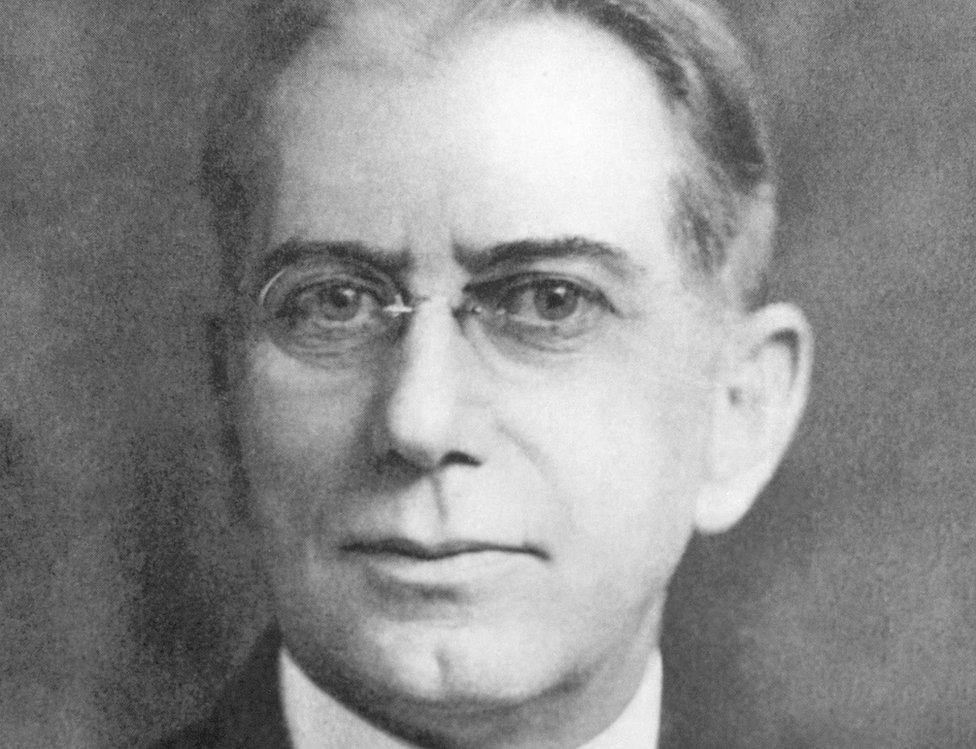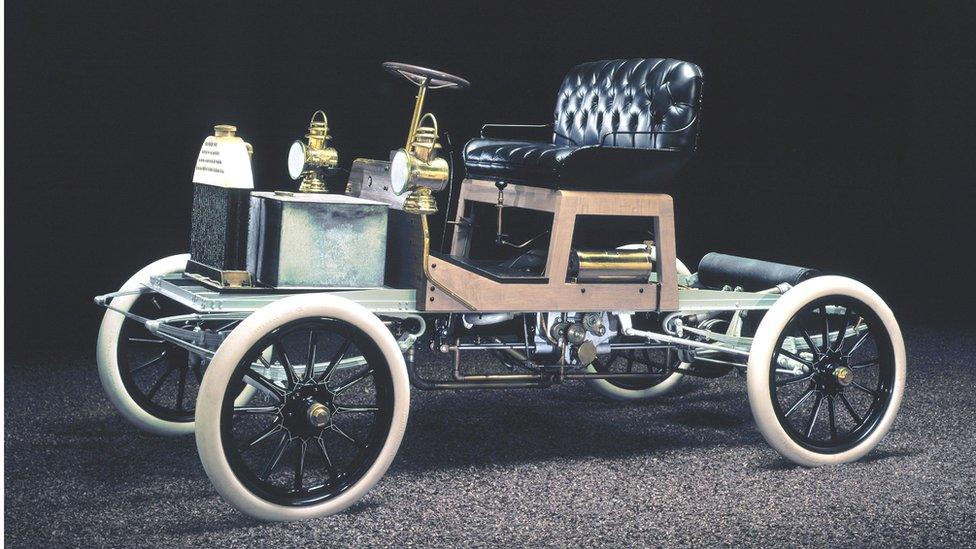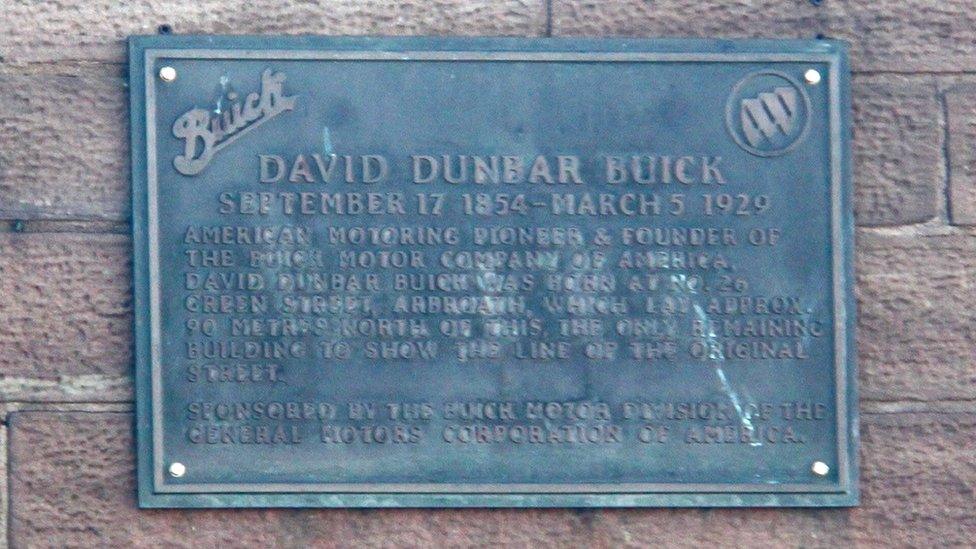David Buick: the motoring pioneer who lost everything
- Published

As inventors go, David Dunbar Buick is up there with the best of them.
During his lifetime, he came up with a lawn-sprinkler system, a toilet flushing device and a way to enamel cast-iron sinks and bathtubs, a process which is still used to this day,
But his greatest claim to fame was the creation of a vehicle which was to become the foundation of one of the world's biggest car producers, General Motors.
More than 50 million vehicles have carried the name of Buick over the past century.
But despite making not just one, but two fortunes, he was to end up virtually penniless.
His story prompted one contemporary American businessman and philanthropist to say: "He sipped from the cup of greatness, and then spilled what it held."
But just how did this happen?
Buick's story suggests that he had the brilliance of an inventor but little business sense.

A replica of a 1904 Buick Runabout
Having moved from Arbroath in Scotland to the US as a toddler in 1856, he went on to co-found a plumbing business.
It was to prove one of his only resounding successes, as he tapped into his inventive genius.
But Buick wasn't happy. By the end of the 19th Century, he had found another obsession - the internal combustion engine.
He sold up his share of the plumbing business for an eye-watering $100,000 (equivalent to $3.3m or nearly £2.5m today) and started his own automobile firm.
Buick Auto Vim was to create the overhead valve engine - still used to this day - but by 1902, he had only produced one car and his money had run out.
He was bailed out by William Crapo Durant, who took over the Detroit-based business and went on to found General Motors (GM), which until relatively recently was the largest manufacturer of cars in the world.
GM has paid tribute to Buick, stating that "his importance to the modern-day Buick brand and General Motors can't be understated".
A spokeswoman said: "While the story of David Buick is in itself very complicated, without question, had it not been for him, there would be no Buick automobile."

More than 50 million Buick cars have been sold over the past century
Buick was to be pushed out of the company a few years later with another $100,000 pay-off - a fraction of what he might have made if he had kept his shares in the business.
But he ended up blowing his second fortune by investing poorly in California oil prospects and Florida land.
In 1924, at the age of 69, he returned to Detroit jobless and virtually penniless, unable even to afford a telephone in his home.
He finally managed to find a job as an instructor at the Detroit School of Trades, but his health was failing.
'Hunched little old man'
Arbroath-based retired journalist Ian Lamb, who has campaigned to have a statue erected in the town to commemorate Buick's life, explains: "As he grew more feeble, he was found a more menial task on the information desk where he was remembered as a thin, hunched little old man who peered at visitors through heavy glasses."
In March 1929, he died of pneumonia at the Harper Hospital in Detroit following an operation to remove a tumour in his colon. He was 74.
In an interview shortly before he went into hospital, Buick said: "I'm not worrying. The failure is the man who stays down when he falls, the man who sits and worries about what happened yesterday instead of jumping up and figuring what he's going to do today and tomorrow.
"That's what success is - looking ahead to tomorrow. I'm not accusing anyone of cheating me. It was the breaks of the game that I lost out on in the company I founded."

A plaque was erected to commemorate David Buick in Arbroath in 1994
In June 1994, a commemorative plaque was erected on the walls of the former Masonic Hall in Arbroath - the only surviving building from the street in which he was born.
When the plaque was unveiled, Robert Coletta, a senior executive with General Motors, said: ''Buick has been one of the great names in American automobiles through virtually all of the 20th Century.
''It is certainly appropriate for us to honour this man, not only because his name identifies our automobiles but because his genius and hard work formed the beginning of an unsurpassed automotive success story which is still being written.''
Since then, Buick's star has waned and he appears in danger of becoming Arbroath's forgotten son.
Two years ago, the New York Times reported, external that the Buick name was no longer being stamped across the back of its North American models. In China - where most Buicks are sold nowadays - the nameplate has already disappeared.
And despite the efforts of Ian Lamb and others, there are no plans to stamp Buick's name in the history books with a statue in his home town.
'Major advances'
All that remains of his legacy in Arbroath is the commemorative plaque on the side of a wall obscured from the view of most local residents.
Ian Lamb says a statue would be a fitting tribute to the car pioneer.
"In David Buick we have someone who was responsible for major advances in the development of motor cars, advances which are still relevant across the world to this day.
"Yet how many people know this inventive genius was born here in Arbroath?
"Yes, we have a plaque marking the last remaining building from the street where he was born, but even the majority of people living in the town would be hard put to place it.
"Buick deserves to be remembered."